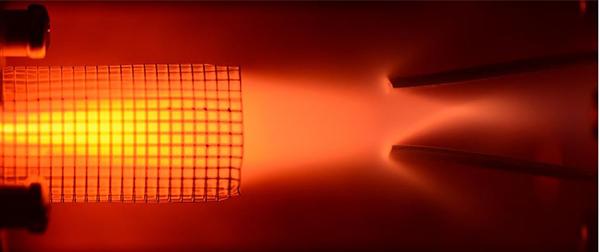How to reduce shockwaves in quantum beam experiments

As the skimmer temperature is lowered, the density of the beam rises. Pulsed discharged enabled the researchers to visualize the beam density Credit: Weizmann Institute of Science
The tiny cone-shaped “skimmers” used in experiments looking for exotic chemical-quantum phenomena resemble the intake mechanisms of aircraft engines, and they perform similar functions: Each directs the flow of gas – the engine intake controls the supply of air for burning fuel, and the “skimmer” creates beams of cold flying atoms or molecules.
While skimmers have been a necessary component in atomic and molecular-beam experiments for decades, they were also known to impose a fundamental limit on the number of particles one could pack into the beam. However, Prof. Edvardas Narevicius and his team in the Weizmann Institute of Science's Chemical Physics Department have now revealed a simple way to overcome this limit.
Cold-beam experiments are conducted in labs around the world to observe atoms and molecules behaving in a quantum manner – as, for example, waves that interfere with one another. Adding beams together, as Narevicius and his group do in their lab, creates new and interesting chemical reactions.
Narevicius explains that the extreme cooling needed for such experiments – close to absolute zero – is accomplished by spraying a gas of atoms or molecules through a small nozzle into a vacuum chamber, from high pressure to nearly none. The atoms in the experiment spread out, forming a very cold cloud of atoms that are moving very fast. Skimmers are used to direct some of these atoms into a beam.
“One would think,” says Narevicius, “that if the gas in the canister is at a higher pressure, and thus releases more atoms at once into the vacuum chamber, the resulting beam would have a higher density. But that is not the case. Above a certain pressure the density levels off. Researchers have not known how to overcome this limit, placing many interesting experiments beyond reach.”
“This was a perfect problem for my student, Yair Segev,” adds Narevicius. Segev came to the Weizmann Institute with expertise in aerospace technology and physics. Beginning with an algorithm used by aerospace engineers to model flows high in the atmosphere, he created simulations of the particle flow in the skimmers. These simulations revealed the existence of shockwaves within the skimmer cones, which blocked the subsequent flow of particles in the beam.
This phenomenon emerges from interactions between the beam's particles and the cone: particles bounce off the skimmer at high velocities, colliding and disrupting the beam's flow. The high reflected velocities result from the “hot” (that is, room temperature) surface of the skimmer, so Segev tried the simulation with cooled skimmers. The results showed a significant reduction in the shockwaves, as well as much denser beams behind them.
Next the team undertook experiments with various molecular beams, chilling their skimmers to progressively lower temperatures. Performing the tests with neon and other types of fluorescing plasma enabled them to clearly observe the colorful results. The researchers found that the shape of the shockwaves was significantly changed and the density of the beams indeed rose with skimmer cooling, peaking when the temperature was below some tens of degrees above absolute zero – cold enough to freeze atoms to the tip of the cone and thus allow the rest to flow through “without feeling any disturbance from the skimmer,” says Narevicius.
“The shockwaves in and around the skimmers turn out to be similar to those that a spacecraft experiences when it crosses the boundary between the vacuum of space and the upper atmosphere,” says Segev. “In both cases, suppressing the heat transferred between the surface and the gas can drastically change the shape of the flow. In the spacecraft we want to keep the atmosphere from heating the shell, while in our experiments we want to prevent the skimmer from heating up our cold beams.”
###
Prof. Edvardas Narevicius' research is supported by the Helen and Martin Kimmel Award for Innovative Investigation; and the European Research Council.
Media Contact
All latest news from the category: Physics and Astronomy
This area deals with the fundamental laws and building blocks of nature and how they interact, the properties and the behavior of matter, and research into space and time and their structures.
innovations-report provides in-depth reports and articles on subjects such as astrophysics, laser technologies, nuclear, quantum, particle and solid-state physics, nanotechnologies, planetary research and findings (Mars, Venus) and developments related to the Hubble Telescope.
Newest articles

First-of-its-kind study uses remote sensing to monitor plastic debris in rivers and lakes
Remote sensing creates a cost-effective solution to monitoring plastic pollution. A first-of-its-kind study from researchers at the University of Minnesota Twin Cities shows how remote sensing can help monitor and…

Laser-based artificial neuron mimics nerve cell functions at lightning speed
With a processing speed a billion times faster than nature, chip-based laser neuron could help advance AI tasks such as pattern recognition and sequence prediction. Researchers have developed a laser-based…

Optimising the processing of plastic waste
Just one look in the yellow bin reveals a colourful jumble of different types of plastic. However, the purer and more uniform plastic waste is, the easier it is to…


